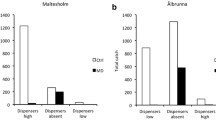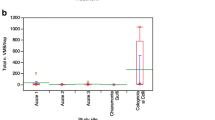Abstract
The efficacy of microencapsulated sprayable pheromone was evaluated at different application rates and intervals for mating disruption of the oriental fruit moth,Grapholita molesta (Busck), in apple orchards during 2002. The following treatments were arranged in a randomized complete block design with three replications: (i) a low rate of pheromone (6.2 g a.i. ha−1) applied at 14-day intervals, (ii) a medium rate of pheromone (12.4 g a.i. ha−1) applied at 28-day intervals, (iii) a high rate of pheromone (24.7 g a.i. ha−1) applied at 28- day intervals, and (iv) a non-pheromone control (insecticides only). The combination of a single insecticide application against first generationG. molesta at petal fall with one pheromone application each for the second, third and fourth generations at 12.4–24.7 g a.i. ha−1 successfully controlled low populations. Pheromone-treated blocks. had significantly lower trap catches than those in the insecticide-treated control blocks. Among pheromone treatments, significantly more moths were caught in the 6.2 g compared with the 12.4 and 24.7 g rates. Fruit damage was <1% at harvest and there were no significant differences among treatments. Low rate frequent applications of sprayable formulation appeared to be effective under low pest pressure but efficacy declined with increasing populations. Further studies are needed to demonstrate the effectiveness of this approach under higher pest pressure.
Similar content being viewed by others
References
Barnes, M.M., Millar, J.G., Kirsch, P.A. and Hawks, D.C. (1992) Codling moth (Lepidoptera: Tortricidae) control by dissemination of synthetic female sex pheromone.J. Econ. Entomol. 85:1274–1277.
Borchert, D.M., Walgenbach, J.F., Kennedy, G.G. and Long, J.W. (2004) Toxicity and residual activity of methoxyfenozide and tebufenozide to codling moth (Lepidoptera: Tortricidae) and oriental fruit moth (Lepidoptera: Tortricidae).J. Econ. Entomol. 97:1342–1352.
Carde, A.M., Baker, T.C. and Carde, R.T. (1979) Identification of a four-component sex pheromone of the Oriental fruit moth,Grapholita molesta (Lepidoptera: Tortricidae).J. Chem. Ecol. 5:423–427.
Chapman, P.J. and Lienk, S.E. (1971) Tortricid Fauna of Apple in New York.Spec. Publ. NY Agric. Exp. Stn. Geneva.
Charmillot, P.J. and Pasquier, D. (2001) Preliminary trials to control grape berry mothEupoecilia ambiguella and codling mothCydia pomonella by means of 3M microencapsulated pheromones.IOBC/WPRS Bull. 24: 63–64 (French, with English summary).
Ellis, N.H. and Hull, L. (2001) Efficacy studies with 3M sprayable oriental fruit moth pheromones and puffers — Summer 2001.Proc. 77th Cumberland-Shenandoah Fruit Workers Conf. (Winchester, VA, USA), pp. 73–83.
Epstein, D., Gut, L., McGhee, P. and Haas, M. (2003) Evaluation of new mating disruption formulations.Proc. 77th Annual Western Orchard Pest and Disease Management Conf. (Portland, OR, USA), pp. 1–6.
Fitzpatrick, S. (1999) 3M sprayable pheromone for mating disruption of blackheaded wireworm: Use in IPM programs and examples from research trials.in: Roper, T.R. [Ed.]Wisconsin Cranberry School Proceedings. University of Wisconsin-Madison, Madison, WI, USA 10: 46–51.
Gentry, C.R., Beroza, M., Blythe, J.L. and Bierl, B.A. (1974) Efficacy trials with the pheromone of the oriental fruit moth and data on the lesser appleworm.J. Econ. Entomol. 67:607–609.
Gut, L. and Wise, J. (1998) Novel tactics for managing tree fruit pests in Michigan.Proc. Mich. State Hortic. Soc. 127:60–68.
Hull, L., Myers, C., Ellis, N. and Krawczyk, G. (2003) http://www.idfta.org/cft/2003/april/page21.pdfCompact Fruit Tree 36:21–25.
Jones, O.T. (1998) Practical applications of pheromones and other semiochemicals.in: Howse, P.E., Stevens, I.D.R. and Jones, O.T. [Eds.] Insect Pheromones and Their Use in Pest Management. Chapman and Hall, London, UK. pp. 263–276.
Koch, U.T., Ascherl, M. and Weber, M. (2002) Field EAG measurements of sprayable pheromone for mating disruption ofSesamia nonagrioides.IOBC/WPRS Bull. 25:85–94.
Kovanci, O.B., Walgenbach, J.F. and Kennedy, G.G. (2004) Evaluation of extended-season mating disruption of the oriental fruit mothGrapholita molesta (Busck) (Lep., Tortricidae) in apples.J. Appl. Entomol. 128:664–669.
Moffitt, H.R. and Westigard, P.H. (1984) Suppression of the codling moth populations on pears in southern Oregon through mating disruption with sex pheromone.J. Econ. Entomol. 77:1513–1519.
Polavarapu, S., Lonergan, G., Peng, H. and Nielsen, K.E. (2001) Potential for mating disruption ofSparganothis sulfureana (Lepidoptera: Tortricidae) in cranberries.J. Econ. Entomol. 94:658–665.
Pree, D.J., Whitty, K.J., van Driel, L. and Walker, G.M. (1998) Resistance to insecticides in oriental fruit moth populations (Grapholita molesta) from the Niagara Peninsula of Ontario.Can. Entomol. 130:245–256.
Rice, R.E. and Kirsch, P. (1990) Mating disruption of the oriental fruit moth in the United States.in: Ridgeway, R.L., Silverstein, R.M. and Inscoe, M.N. [Eds.] Behavior-modifying Chemicals for Pest Management: Applications of Pheromones and Other Attractants. Marcel Dekker, New York, NY. pp. 193–211.
Rotschild, G.H.L. (1975) Control of oriental fruit moth (Cydia molesta (Busck) (Lepidoptera: Tortricidae) with synthetic female pheromone.Bull. Entomol. Res. 65:473–490.
SAS Institute (2000) SAS/STAT User’s Guide, Version 8. SAS Institute Inc., Cary, NC, USA.
Stockel, J., Schmitz, V., Lecharpentier, P., Roehrich, R., Torres Vila, M. and Neumann, U. (1994) Mating disruption of the grape mothLobesia botrana (Lepidoptera: Tortricidae). Results of a five-year experiment in a Bordeaux vineyard.Agronomie 14:71–82 (French, with English summary).
Trimble, R.M., Pree, D.J., Barszcz, E.S. and Carter, N.J. (2004) Comparison of a sprayable pheromone formulation and two hand-applied pheromone dispensers for use in the integrated control of oriental fruit moth (Lepidoptera: Tortricidae).J. Econ. Entomol. 97:482–489.
Trimble, R.M., Vickers, P.M., Nielsen, K.E. and Barinshteyn, G. (2003) Sprayable pheromone for controlling the North American grape berry moth by mating disruption.Agric. Forest. Entomol. 5:263–268.
Usmani, K.A. and Shearer, P.W. (2001) Topical pheromone trap assays for monitoring susceptibility of male oriental fruit moth (Lepidoptera: Tortricidae) populations to azinphosmethyl in New Jersey.J. Econ. Entomol. 94:233–239.
Vogt, H., Schropp, A., Neumann, U. and Eichhorn, K.W. (1993) Field trials on mating disruption to control the European grape mothEupoecilia ambiguella Hbn.J. Appl. Entomol. 217–232.
Waldstein, D.E. and Gut, L.J. (2003) Comparison of microcapsule density with various apple tissues and formulations of oriental fruit moth (Lepidoptera: Tortricidae) sprayable pheromone.J. Econ. Entomol. 96:58–63.
Walgenbach, J.F., Palmer, C.R., Sawyer, M.J., Thayer, C.L. and Schoof, S.C. (2000) Arthropod Management Studies on Fruit and Vegetable Crops in Western North Carolina. Ann. Rep. North Carolina State University, Fletcher, NC, USA.
Author information
Authors and Affiliations
Corresponding author
Additional information
http://www.phytoparasitica.org posting July 13, 2005.
Rights and permissions
About this article
Cite this article
Kovanci, O.B., Walgenbach, J.F., Kennedy, G.G. et al. Effects of application rate and interval on the efficacy of sprayable pheromone for mating disruption of the oriental fruit mothGrapholita molesta . Phytoparasitica 33, 334–342 (2005). https://doi.org/10.1007/BF02981299
Received:
Accepted:
Issue Date:
DOI: https://doi.org/10.1007/BF02981299




